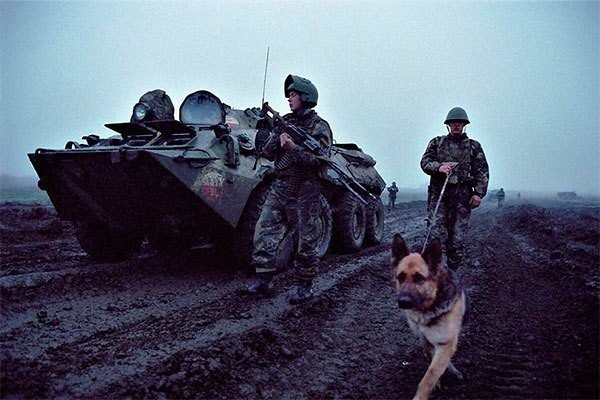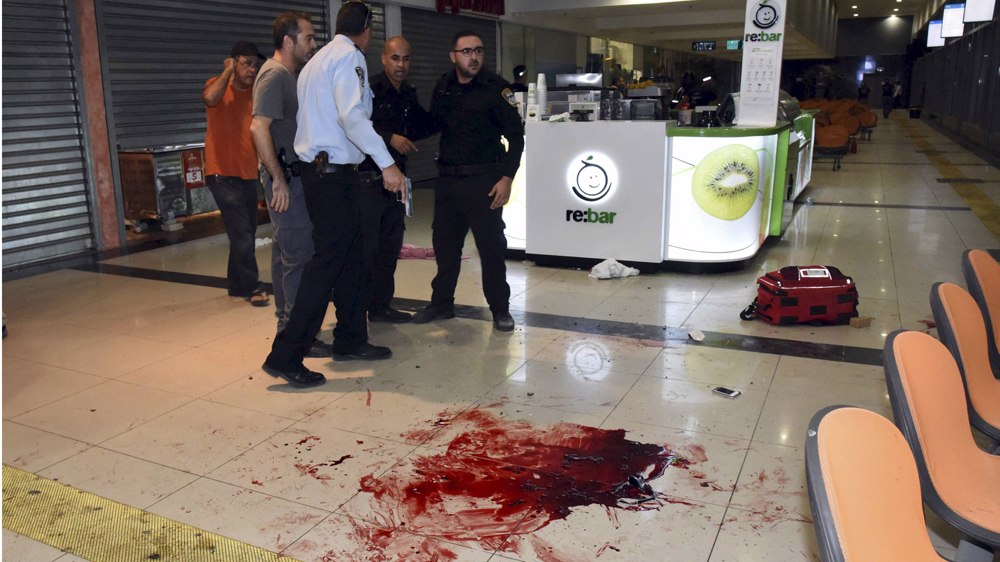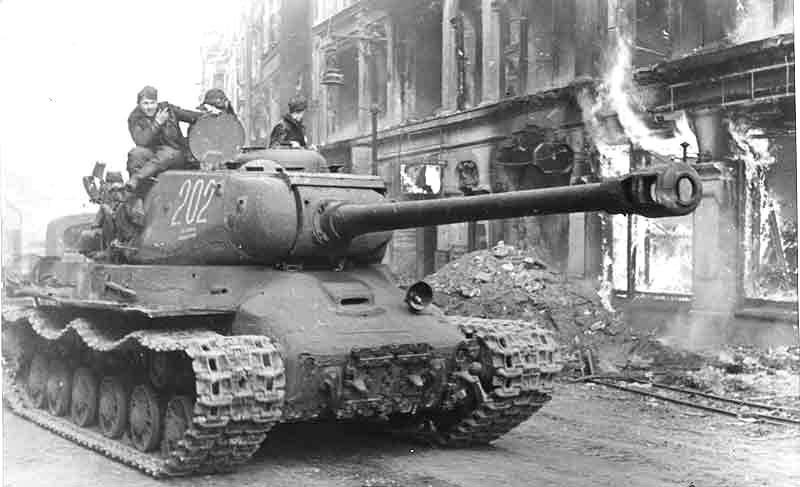
IS-2 - Soviet heavy tank of World War II period. IP stands for "Joseph Stalin" - the official name of the series of Soviet heavy tanks of 1943-1953 years of release. Index 2 corresponds to the second tank series model this family. During World War II, together with the IS-2 designation to still use the name of the IP-122, In this case, index 122 It means the caliber of the main armament of the machine.
Tank Is-2 – video
IS-2 was the most powerful and most heavily armored of Soviet and Allied production period of the war of tanks, and one of the best tanks in the time in the world. Tanks of this type played an important role in the battles of 1944-1945, particularly distinguished himself during the assault on the town. After the war ended, the IS-2 have been upgraded and were armed with Soviet and Russian armies to 1995 of the year. Also, the IS-2 tanks were supplied to several countries and participated in some of the post-war armed conflicts.
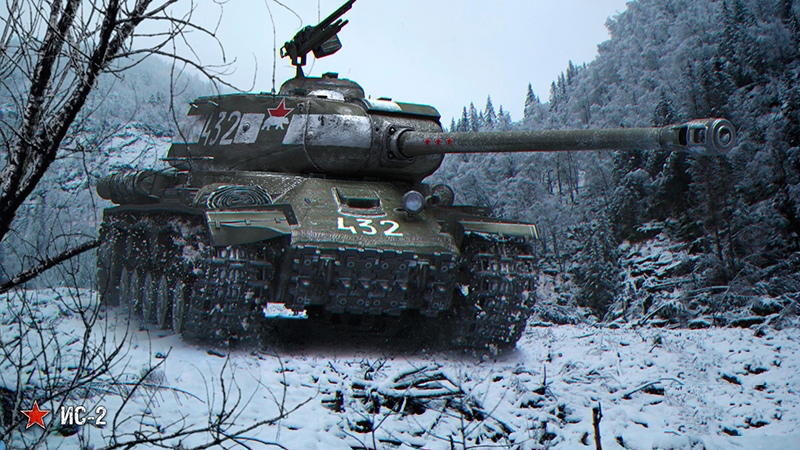
History of creation
Heavy Tank IS-2, IS-85 (IS-1) and SW 85 are descended from heavy tank KV-1 / KV-1c.
IS-85 (IS-1) and KV-85 were adopted in September 1943 of the year, but in the end 1943 it became clear, that they have not enough for heavy tank weapons. Experience combat use 85-mm gun D-5 on the self-propelled artillery SU-85 and experienced the shooting of captured heavy German tanks showed, that gun D-5 does not achieve a decisive superiority over the German tank weapons, Furthermore, in its armor penetration, it gives the German 88-mm tank guns and 75-mm cannon KwK 42 L70, installed on the tank "Panther". Also of note, 85-mm D-5T gun at a distance of 500-1000 m caliber armor-piercing projectile could pierce forehead German heavy tank "Tiger I» only when hit, close to normal; upper frontal part "Panther" did not break at all. This puts the new Soviet heavy tank at a disadvantage against the background of ever-increasing numbers of "Panther" on the Eastern Front.
Since the main use of heavy tanks was to break heavily fortified enemy defenses bands, saturated and long-term field fortifications, the high-explosive projectiles action plays an equally (if not more) important role, as well as armor-piercing. 85-mm shells, borrowed from the anti-aircraft gun 52-K, We do not have the high explosive variant (they were shrapnel); although the installation of some types of fuses that they can be used as a high explosive, but their action was only slightly better, than the 76-mm ammunition. This fact was also tested self-propelled artillery - to deal with pillboxes and bunkers strong Soviet commanders preferred SU-122, but not SU-85. However, the tower and the gun mounting structure in IC tank had a significant reserve to install more powerful artillery systems.
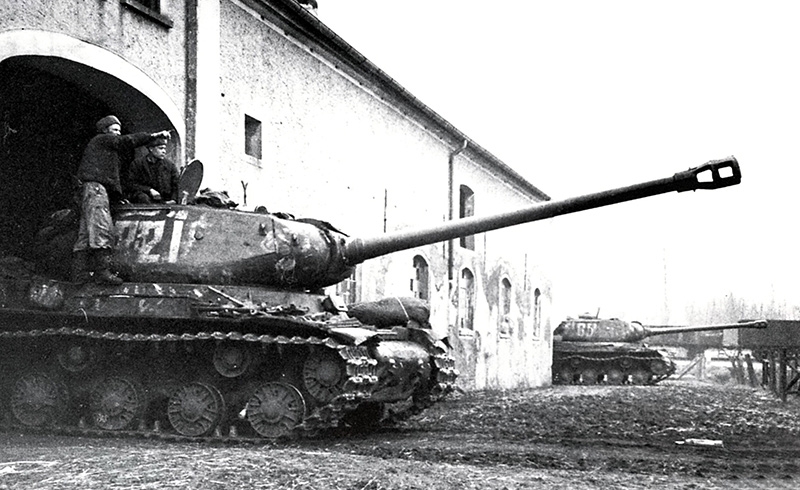
IS-2 in ambush. 1-First Byelorussian Front
The choice of weapons
In September 1943 , the famous Soviet artillery designer F. F. Petrov sent a letter to the chief designer and pilot plant CHKZ number 100 F. I. Kotin the possibility of installation in tanks IS-caliber artillery systems 107, 122 and even 152 mm. F. I. Kotin chosen to enhance tank armament IP 122 mm cannon A-19. After agreeing on the technical details he has received the consent of the person and. AT. Stalin installation gun A-19 IP tank. The design bureau of the plant number 9 under the direction of F. F. Petrova A-19 has been redesigned to be installed in the tank - it was equipped with a muzzle brake to mitigate the significant impact, more compact recoil device, moved to one side of the controls for the convenience of the gunner in the combat tank cramped office. This modified version of the A-19 was named D-25T, and its mass production was started at the plant number 9 immediately. Initially, it had difficulty mastering, therefore considering the issue of the installation of IP directly cannon A-19. However, they managed to overcome, and subsequently installing A-19 in the tank is not required.
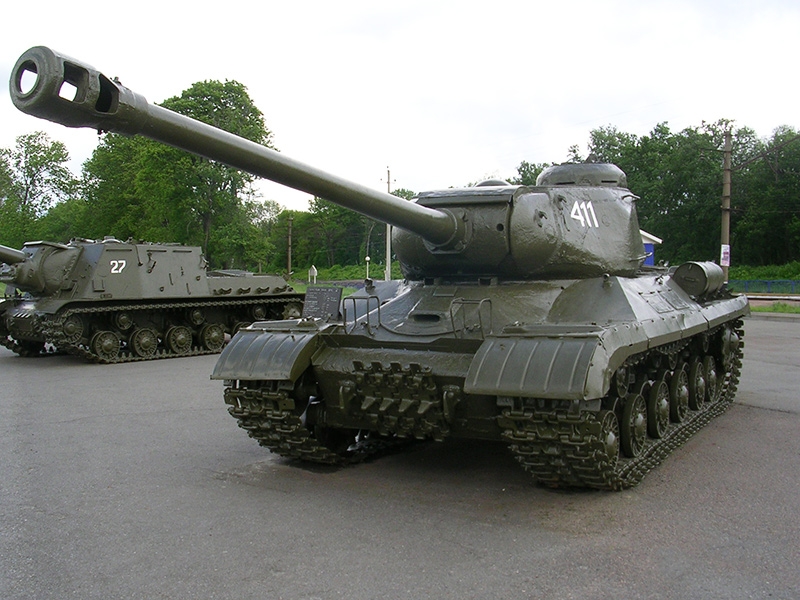
test
At pilot plant № 100 gun prototype D-25 was installed on the former "Object 237» № 2 - an experienced IS-1 variant with the D-5T gun. This experimental machine received the designation "Object 240". In October - November at the Chebarkul training ground took its test mileage and shooting. Initially, D-25 was equipped with a T-shaped muzzle brake, which exploded at a test firing. Some sources claim, that in this case almost was killed Marshal Voroshilov, was present at the trial. Subsequently, EC established two-chamber muzzle brake German type, and then the plant number 9 He has developed a dual-chamber design of the muzzle brake, which became installed on production machines.
IS-2 adopted by the Soviet armored forces according to the decision number of T-bills 4479 from 31 October 1943 of the year. After successful tests "Object 240" received an order for the immediate launch it into mass production on CHKZ. In November 1943 the year began assembling the first mass-produced cars. The new tank has received an index modification of IS-2 (during the war with him on equal terms to use the designation -122, first samples sometimes also termed as the parts in the HF-122). Production continued from December 1943 to June 1945, few cars of this brand has also released the Leningrad Kirov factory.
Fighting IS-2 adopted at the beginning of the baptism 1944 of the year, Moreover, it was forced to, cutting short a planned thorough training crews for the new machine. Demonstrated in battle fighting qualities immediately led to the order to maximize the volume of the IS-2 production. In this test work was cut short, with the result that the front has gone so many nedovedonnyh machines, and outages have caused a large number of complaints from the troops. To ensure the quality of mass-produced IS-2 and their improvement at the beginning of 1944 year F. I. Kotin and a number of his staff was removed from the design work on the new machines in order to eliminate defects in the IC-2 design. Lapping machines are hard: So, in April 1944 the military has reported acceptance of, that a significant improvement in quality of the on CHKZ tanks IS-2 and ACS based on it did not happen. However, in summer 1944 , the ongoing work to improve the quality given its first fruits - about a third of manufactured tanks managed to pass the acceptance the first time, and from November 1944 , the quality of the tank was officially recognized as satisfactory - F. I. Kotin was returned to the post of head of KB CHKZ and pilot plant number 100. in winter 1944/1945 gg. reports from the troops showed, EC-2 accident-free operation of the warranty cover the mileage in 1000 km. Streamlined production mechanism for the production of the IS-2 has led to the, the machines 1945 year of manufacture were considered quite reliable and undemanding in operation.
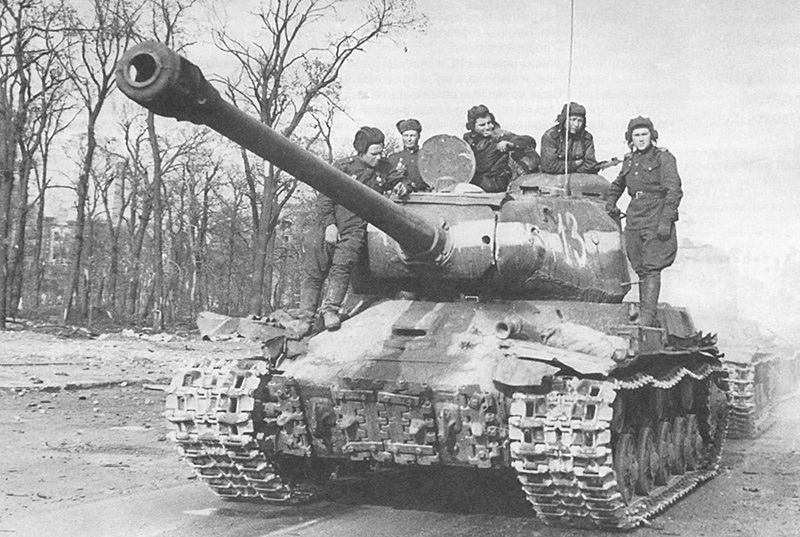
Strengthening the protection of the tank
In parallel with the work to increase the reliability of surveys were conducted to strengthen the armor IS-2. First option, even though he was the best of armor protection of all Soviet tanks, relatively easily struck 88-mm tank and antitank guns Wehrmacht. 75-mm long-barreled guns also represents a significant threat to him. After analyzing the defeat, designers CHKZ concluded, that strengthening the armor of the tower is no longer possible without a radical alteration of the whole structure, which it was impossible in the harsh conditions of serial production. Installing the 122-mm gun turret and weighing violated its balance - the center of mass is not lying on the tower axis of rotation, that are designed and equilibrated at 85 mm instrument D-5. Optional booking, apart from the general weighting machine, It would lead to the impossibility of manually turning the turret at any significant bank machines and require a much more powerful electric motor to rotate the drive. Therefore, the tower was left unchanged. Protection of armored housing could greatly improve, replacing the "step" in the upper front part spryamlonnuyu. There have been cases, when the upper frontal part did not break even at close range of the most powerful 88-mm anti-tank gun Pak 43. However, the lower frontal part remains vulnerable. The thickness of the frontal armor reached 120 mm, board - 90 mm, but frontal bronedetal in some tanks were cast, not rolled (the latter at equal thickness provides a better protection against penetration).
further work
Further work to strengthen the security of heavy tanks were conducted in parallel in two groups - engineers CHKZ and pilot plant number 100. Interesting, that was the head of both CB F. I. Kotin. Each of the groups promoted their projects, but in a series of 1945 , under the IS-3 index went associate option "Object 703", which the, in fact, IS-2 was dramatically redesigned with armored protection taking into account the experience of the Great Patriotic War.
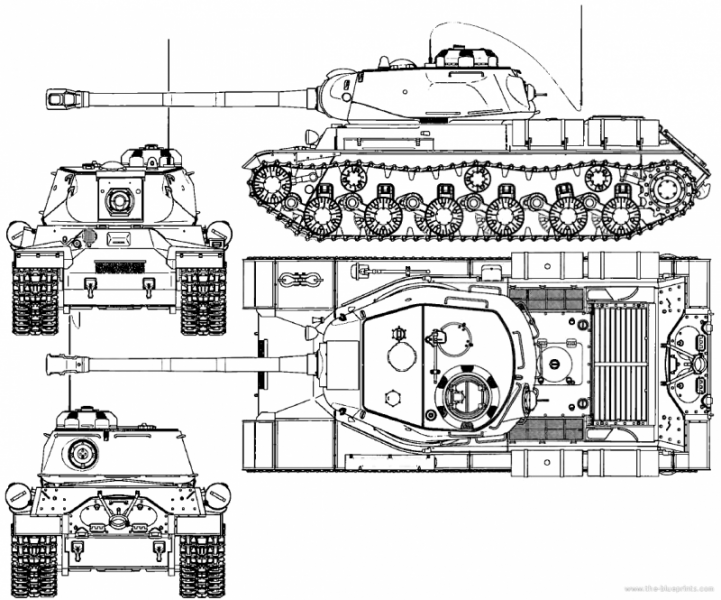
Projections of the JS-2
Design
arrangement
IS-2 is essentially a further improvement of EC-1 tank, which the, in its turn, It was a deep modernization of the previous model KV-1 heavy tank. Compared with the IS-1 was significantly more than reinforced arms, and modifications to arr. 1944 g. with spryamlonnym frontal book has also been enhanced immunity to enemy fire in the front sector. Like all other Soviet serial heavy and medium tanks of the time, IP-2 had a classic layout. Hulls from bow to stern successively divided into the control compartment, fighting compartment and engine-transmission compartment. The driver was located in the department of management, Three other crew members had jobs in the fighting compartment, is united armored housing middle part and the tower. There's also located a weapon, ammunition to it and some of the fuel tanks. The engine and transmission were installed in the rear of the vehicle.
CHKZ designers desire to receive the maximum reservation of the relatively modest weight and dimensions of the entire tank as a lead to positive, and negative consequences. The positive side was the economy and a relatively small consumption of materials IS-2 as a whole - at the same weight, 46 t Soviet tank was much more protected, than "Panther", superior on this parameter 55 tonne "Tiger I» and slightly inferior to 68 unit-of production "tigers II». Cons were the logical continuation of this approach - because of the tight layout had to give up the driver's hatch and place of the fuel tanks in the fighting compartment. As a result, IP-2 lesion there is a significant chance of ignition of diesel fuel and entering it into tankers. The German tanks, fuel tanks located outside the inhabited places of the machine (although they also had a number of units with flammable liquids). The absence of the driver's hatch more than once led to the, that the wounded crewman could not quickly leave the burning car (I needed to get out through the tower after the other crew members) and died from suffocation or flame. By not so significant disadvantages due to the layout of the tower in the presence of the radome. Together with a long gun is difficult to overcome such obstacles, as the ditches and counterscarps. Some of them just could boost deploying tower gun ago, ie in a battle with the presence of the IS-2 barriers losing firepower. All German heavy tanks tower located in the center of the armored housing, and a long flight gun barrel is not so much hampered overcoming obstacles.
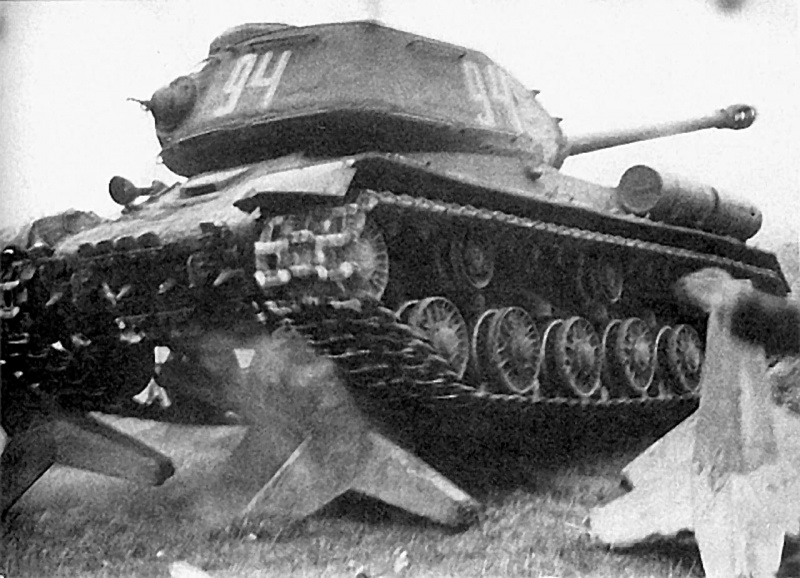
IS-2 tank overcomes the concrete anti-tank "hedgehogs". East Prussia, 3-First Byelorussian Front, January 1945 g.
Armor hull and turret
IS-2 has differentiated protivosnaryadnym armor protection. Body armor tank (except at the front part of the machine) welded from rolled armor plate thickness 90, 60, 30 and 20 mm. The design of the frontal parts varied depending on the car modification:
– IS-2 obr. 1943 g. had cast a frontal detail of the streamlined "step" form, in different parts of its thickness varied from 60 to 120 mm.
– IS-2 obr. 1944 g. to increase snaryadostoykosti frontal armor was equipped with advanced "spryamlonnoy" design of this part. Instead streamlined tip speed of complex geometric shapes forehead IS-2 mod. 1944 g. formed by two flat armor plates, the upper of which has a shape tapering towards the top of the tank and the trapezoid inclination of 60 ° to the normal. Part of the issued EC-2 mod. 1944 year were equipped with cast front piece, wherein the thickness of armor reached 120 mm; since the second half 1944 years as available high hardness armor rolled frontal portion of the welded steel making 90mm armor plates.
With other parts frontal part was connected by welding. The streamlined tower was an armor casting of complex geometric shapes, its board thickness 90 mm arranged at an angle to the vertical to improve snaryadostoykosti. The frontal part of the tower with loopholes for guns, formed by the intersection of four spheres, It was cast separately and welded to the rest of the tower bronedetalyami. gun mantlet was a cylindrical segment bent and rolled armor plate had three openings - for cannons, coaxial machine gun and sight. The tower was placed on the shoulder straps with a diameter 1800 mm armored fighting compartment roof and fixed grippers avoid stalling under strong roll or roll-over of the tank. The surface of the "contact" of the lower turret and overhead armored housing was slightly recessed into the roof of the crew compartment, thus eliminating jamming towers when shelling. Turret marks out in thousandths firing from covered positions. For convenience in the repair and maintenance of motor units, drive train roof of the engine compartment has been made removable, while the upper armored plate feed can be folded on the hinges.
The driver is centered in front of the tank armored housing. Compared with the tank KV-1S dense arrangement JS tank inhabited space is not allowed to place in him the fifth member of the crew - radio operator-gunner. Its functions were distributed between the commander and driver: first I worked with the radio station, and a second led unsighted gun fire from a course by pressing the trigger elektrospuskovogo mechanism on one of the control levers. ESP himself a machine gun located to the right of the driver and rigidly mounted in a special armored pipe, which is welded to the front of the tank bronedetali. later, due to the low efficiency unsighted fire and weakening frontal booking, by localizer gun and refused to do. Three crew members were located in the tower: left of the gun had jobs gunner and tank commander, and on the right - loader. Vehicle commander was cast with the vertical observation turret armor thickness to 82 mm. Planting and crew carried out through hatches in the tower: round two-folding hatch commander's cupola and a round trapdoor Single-loader. The housing also had of the bottom hatch for emergency escape of tank crews and a number of hatches, hatches and technological openings for loading ammunition, access to fuel tanks, other nodes and aggregates machines.
To the tank's hull was welded a number of details - limiters rocker stroke and torsion bar suspension brackets, Bonki for support rollers and gryazeochistiteley, stopper mounting tension caterpillar mechanism.
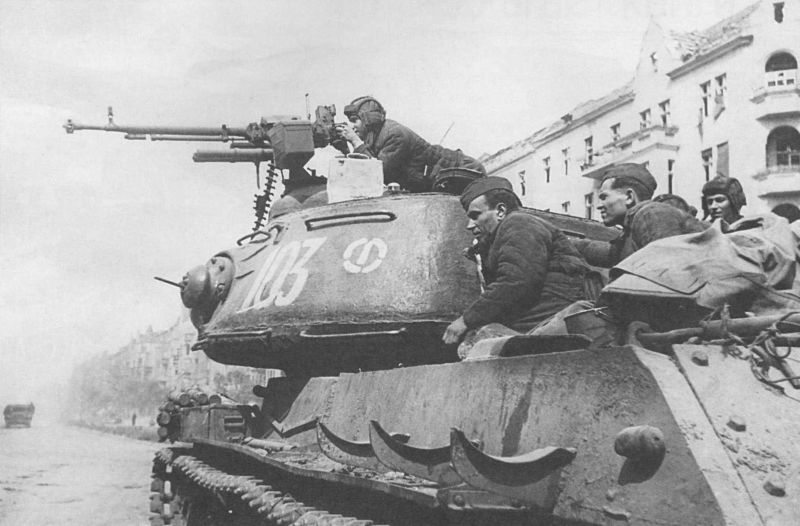
The security
As an estimate of the vulnerability of IC 2 can give some emotional judgment of the monograph "IP Tanks", that the IS-2 tank was the only place large-scale tank anti-Hitler coalition, whose book provided some protection from the well-known 88-mm long-barreled guns and 75mm guns, while all other (with the exception of the later versions of the British "Churchill") "Provided his crew is not more protection, than carton '.
In terms of armor protection, 53 % the total mass of the IS-2 had reservations hull and turret, whereas PzKpfw VI Ausf H «Tiger I» this figure was 46,3 %, in PzKpfw V "Pantera" - 38,5 %. German tanks from the best indicator (54,7 %) I had only PzKpfw VI Ausf B «Tiger II», but this was achieved at the cost of a significant increase in weight of the machine as a whole with all its consequences. Head-IS-2 reservations well withstood a German shell: upper part "stepped nose" made its way caliber armor-piercing projectiles 88-mm cannon KwK 36 from 1000-1200 m, 75-mm cannon KwK 42 - from 800-900 m, 75-mm cannon Pak 40 - from 400 m. But for 1944 years is already considered a clearly insufficient, so as a result of intensive work protection forehead IS-2 could greatly improve housing. "Spryamlonnuyu" upper frontal piece 75 mm armor-piercing projectiles and punched at short distances; 88-mm (KwK 36 L/56) armor for cast nose thickness 120 mm - penetrated not in focus, rolled to a thickness of 90 mm - penetrated with 450 m. Achieve security from Pak guns 43 at medium and long range combat and failed. However, it should be taken into account, that in order to achieve this, cast nose should be of good quality, without looseness and voids, it is not always. The lower frontal part made its way 75-mm shells from a distance 785 m, thick mask gun 100 mm also made its way the German 88-mm projectile cannon KwK 36 a distance of the order 1000 m.
AT 1945 year at the site in Kubinka special tests the IS-2 were carried out by firing spryamlonnoy upper front part of the captured German early modification ACS Hornisse, armed powerful 88mm gun system «Panzerjägerkanone» 8,8 cm Pak 43/1 L / 71 with a barrel 71 caliber. As with the 88 mm gun KwK 36, upper frontal part of IP-2 caliber armor-piercing projectile was never broken, but, as expected, the range of the actual destruction of protected places under the tank significantly increased in comparison with the KwK 36.
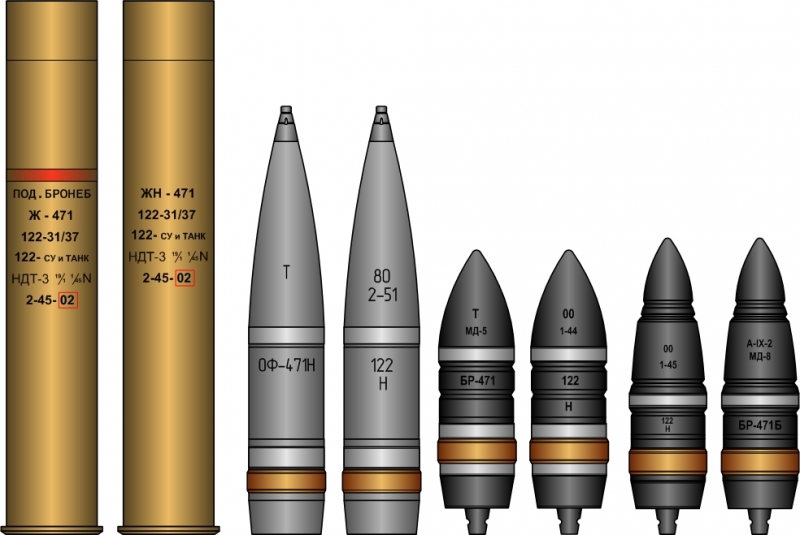
Sleeves and shells tank gun D-25T. From left to right: armor-piercing shot sleeve, sleeve high-explosive shot, high-explosive fragmentation grenade gun RP-471, ostrogolovy armor-piercing tracer BR-471, thick-headed armor-piercing projectile with a ballistic tip BR-471B. All rounds are shown on both sides
weaponry
The main armament IS-2 was a gun D-25T caliber 122 mm. The gun was mounted on the journals in the tower and was completely balanced. However, the overall tower with a gun D-25T was not balanced: its center of gravity is not located on the geometric axis of rotation, making it difficult for her turn at a bank machine. This negative factor was due to the fact, The tower was designed and was equilibrated for 85-mm gun D-5T, which was the original version of IP tank weapons. Installation tools D-25T with a much longer and more massive barrel violated the calculated mass distribution about the rotation axis of the turret. The gun had a D-25T vertical aiming angles from -3 to + 20 °, a fixed position of the tower she could be induced in a small traverse sector (t. n. "Jewelry" leveling). The shot produced by an electric or manual mechanical shutter.
Ammunition gun was 28 rounds of separate loading. Shells and propellant charges them fit into the tower and along both sides of the fighting compartment. Compared with a wide assortment of ammunition 122 mm cannon A-19 - ancestor gun D-25T, ammunition IS-2 was significantly less diverse. It consisted of:
– ostrogolovy armor-piercing tracer BR-471 weight 25 kg (explosive mass (trotyl) — 156 g).
– thick-headed with a ballistic armor-piercing projectile tip BR-471B weight 25 kg (explosive mass (A-IX-2) — ? g); designed in 1944 year, but the troops in mass quantities appeared in the very final phase of the war - spring 1945 of the year.
– high-explosive fragmentation grenade gun RP-471 weight 25 kg (mass of explosives - TNT or Amatol - 3 kg).
All kinds of shells were fired on a full charge F-471, reported that their initial velocity 792-800 m / s.
The tank IS-2 establishes three 7.62-mm machine gun DT: fixed exchange rate, paired with a weapon and the aft ball mount at high tide on the rear part of the tower. Ammunition for all diesel fuel was 2520 cartridges in drives. These guns mounted in such a way, that they can be removed, if necessary, with mounts and used outside of the tank. Since January 1945 , the EC-2 began to install a heavy 12.7 mm anti-aircraft machine gun DSK with red-dot sight K-8T. Ammunition was DShK 250 cartridges in the tape in a box, fastened to the machine gun. Also for self-defense crew I had several hand grenades F-1 and sometimes supplied with a gun for firing flares.
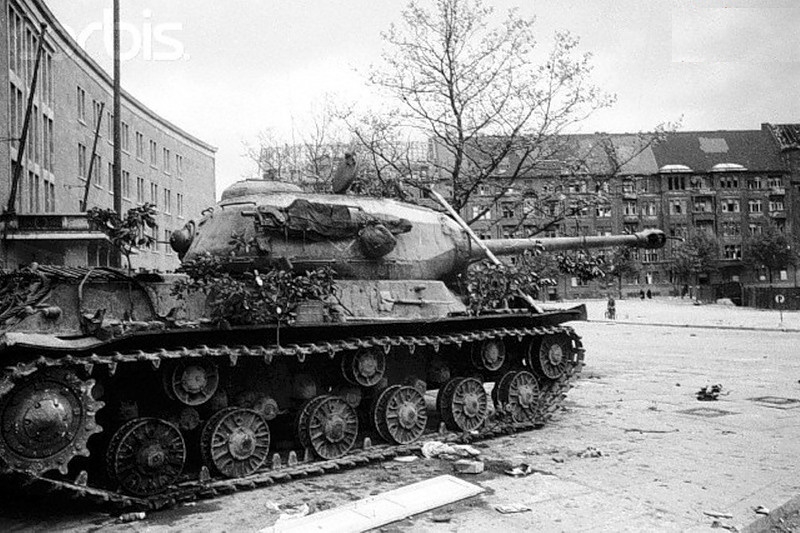
Firepower
122-mm tank gun was a modification of the gun body sample 1931/1937 g. A-19, received index D-25T, It was the most large-caliber serial tank guns of World War II - its muzzle energy was 820 t · m, whereas the 88-mm cannon KwK 43 German heavy tank PzKpfw VI Ausf B «Tiger II» it equaled 520 t · m. Guns KwK 36 и KwK 42 heavy tank PzKpfw VI Ausf H «Tiger I» and medium tank PzKpfw V «Panther" respectively have energy 368 t m and 205 t · m. However, it should be noted, that the quality of manufacturing armor-piercing shells, the Germans were much better, and their range and included Subcaliber cumulative options, whereas before 1945 year for the D-25T produced only an armor-piercing projectile caliber ostrogolovy BR-471. If possible fight with heavy armor is inferior to German tank guns, and is mainly used as an assault gun.
Practical results of firing from guns D-25T and A-19 at the site captured on German tanks jughead projectile BR-471B with the distance 1400 m showed the following results (for some of them there are doubts - as a result of confusion in the documents CHKZ - a tank and at what distance shelled):
– Танк PzKpfw IV Ausf H He was broken bleed through the frontal armor plates and feed.
-Tank PzKpfw V «Panther" in contact with the upper frontal part was damaged armored housing 150 × 230 mm with a crack of the weld; in contact with the side of the tower formed hole 130 × 130 mm, the opposite side of the tower was also broken, and it tore at the weld. When injected into the formed hole forehead tower 180 × 240 mm, the tower was torn from overhead and is offset 500 mm from the axis of rotation.
– Tank PzKpfw VI Ausf H «Tiger I» in contact with 122 mm projectile already existing hole of 85 mm in front of the projectile armor plate was left without 82mm aft armor plates, torn by welds, projectile went completely through all the interior fittings of the tank. When injected into the roof of the tower (thickness 40 mm, angle 80 ° to the normal) I left a dent with a crack on the ricochet projectile; in contact with the forehead of the tower formed a hole 580 × 130 mm, The tower was torn from overhead and is offset 540 mm from the axis of rotation.
– JagdPz SAU "Ferdinand" forehead did not break - 122 mm projectile has struck the first frontal 100mm armor plate to form holes 120 × 150 mm, but it rebounded from the second, if it enters the cabin in the armor plate was left a dent depth 100 mm.
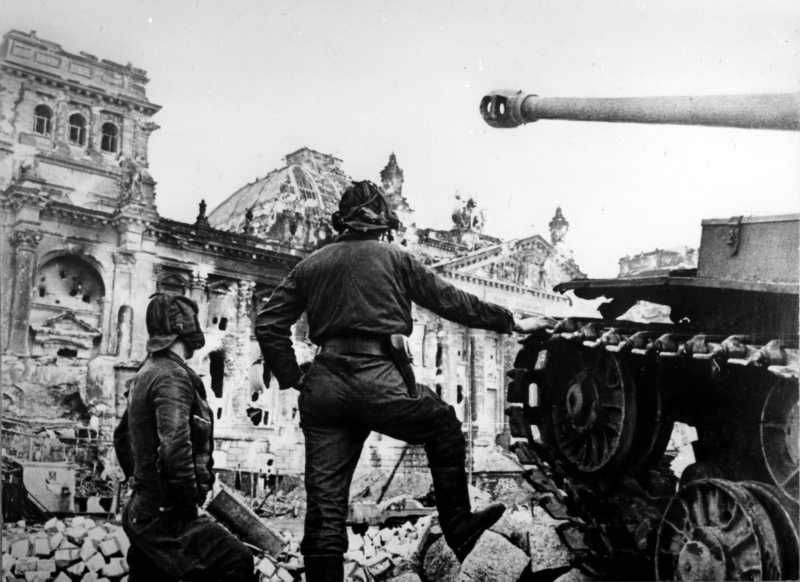
The crew of the Soviet heavy tank IS-2 in front of the ruined Reichstag
Satisfactory results were achieved only armor penetration due to the large mass of the projectile, with the result that greatly reduced the rate of fire weapons and ammunition of the tank reduced in comparison with an armed 85-mm gun "IP-2" more than doubled, to 28 shells. In the beginning of November 1944 year at the site in Kubinka was shot captured heavy tank PzKpfw VI Ausf B «Tiger II». 122-ostrogolovy mm projectile past the upper frontal part (on joints of armor plates) from 600 m, en 88 mm "Tiger II» gun KwK 43 I handled this with bronepregradoy 400 m, a 75-mm gun "Panther" pierced the forehead "Tiger II of" with 100 m.
High power high-explosive 122mm allows us to achieve positive results when shooting at the enemy bronetselyam. It is worth noting, that ravages explosive projectile amplified when placed at an angle relative to the normal lesion. So, high-explosive fragmentation grenade PF-471 when installed on the explosive action when firing in Kubinka on the "Tiger II» in contact with disabling transmission components last and tore the welds of the front. For purely explosive action 122 mm 25 kg 3 kg projectile into Amatol 3 times higher than the same type of German 88-mm high-explosive projectile mass 9,5 kg 1 kg Amatol (dependence on the mass of the projectile caliber cubic, For with the three dimensions of the projectile, ie the quotient of the caliber necessary to raise to the third power: 122 mm / 88 mm = 1,386; 1,386³ = 2,66 times more).
The biggest disadvantage of unavoidable and implements D-25T was a low rate compared with 75-mm and 88-mm cannons German tanks, who could resist the IS-2. This rate was due to the large mass of the projectile and the difficult conditions of work of a single loader. The sequence of operations wherein the interrupted screw was such: shutter opening, lowering the tray, stacking 25 kg projectile tray, dosylka "clinked" it in the bolt dosylnikom, liners preparation, embedding it into the chamber, shutter closing. It should take into account the fact, charging that the majority of these operations are performed with the left hand. Wedges only facilitated the work of the charging rate and slightly raised, which in the best of circumstances is not exceeded 3 shots per minute. In reality, this figure was much lower (that is true not only for IS-2, but also for all tanks), when tested in Kubinka at a speed 12 km / h Combat rate was 1,35 shots per minute. There is an opinion, that low rate was associated with a separate loading gun D-25T, but the results of the test on the range 122-mm gun D-25-44 with the use of a unitary shell is not confirmed.
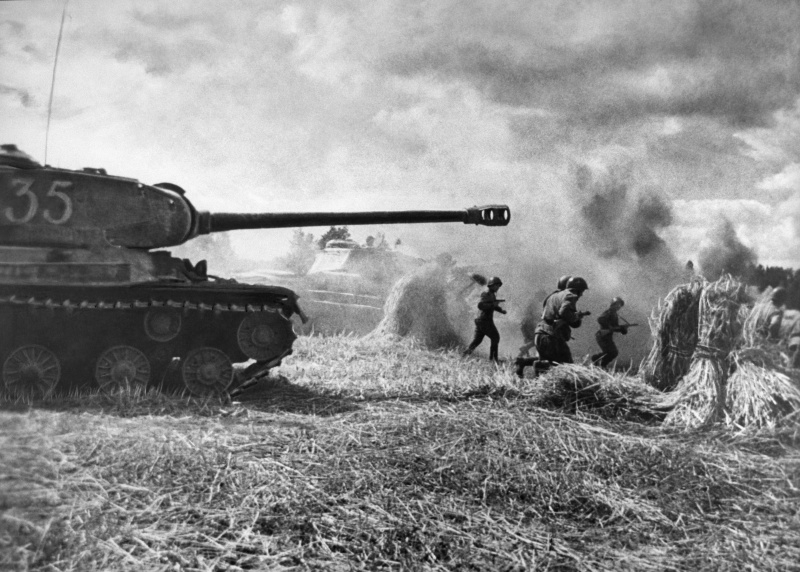
The Red Army, accompanied by heavy IS-2 tanks are on the attack
Patterning bout 122 mm gun D-25T at least not inferior to foreign guns - mean deviation 122 mm armor-piercing projectile of the aiming point when shooting from a place at a distance 1 km was 170 mm vertically and 270 mm horizontally. Soviet tests 88-mm cannon KwK 43 under the same conditions gave deviation 200 mm vertically and 180 mm horizontally. Good results showed EC-2 when firing with a course. In tests in Kubinka at a distance 700 m IS-2 was four times out of five on the tank "Panther" and two of the three on the tank PzKpfw III.
Turret speed EC-2 was 13-16 ° per second, that is, a full turn of the tower required 22-28 with. Power tower allowed to rotate at engine and anechoic machine roll to 15 °. Manual drive tower allowed to rotate in roll 8,3 ° with a force of 16 kgf. for comparison: German heavy tanks have a hydraulic or manual transmission tower. Speed turret hydraulically independent of the engine speed (that is, with the engine off the hydraulic drive was useless), It is in the range from 5 to 19 ° per second. Reports of studies of German heavy tanks in Kubinka claim, that the hydraulic complex and cumbersome, and the management of uncomfortable.
You can also say, that powerful armament IS-2 indirectly increased its The security, forcing the enemy tanks and self-propelled guns to open IP-2 fire with a long range compared to any other battle with Soviet tanks.
Excerpt from the "Report of the Office of the self-propelled artillery, CA Work during the Great Patriotic War "shows:
... installation of 122-mm guns on the IC tanks our tanks back lost at the time of superiority over the enemy in heavy tanks artillery armament. Power his shot 122-mm gun D-25 left far behind the 88-mm gun of German tanks.
Fighting tanks showed IC, that the 122-mm guns are the most effective means of struggle against the heavy and medium tanks of the enemy, providing the penetration of armor from a distance 2500 m ...
Excerpt from the "Report of the fighting 71st OGvTTP from 14.07.44 by 31.08.44 Mr. ":
... firepower weapons IS-122 tank is the most powerful of all the existing types of tanks. 122-mm projectile has a high penetrating ability, that determines the quality of these tanks as the best way to fight against heavy tanks of the enemy ...
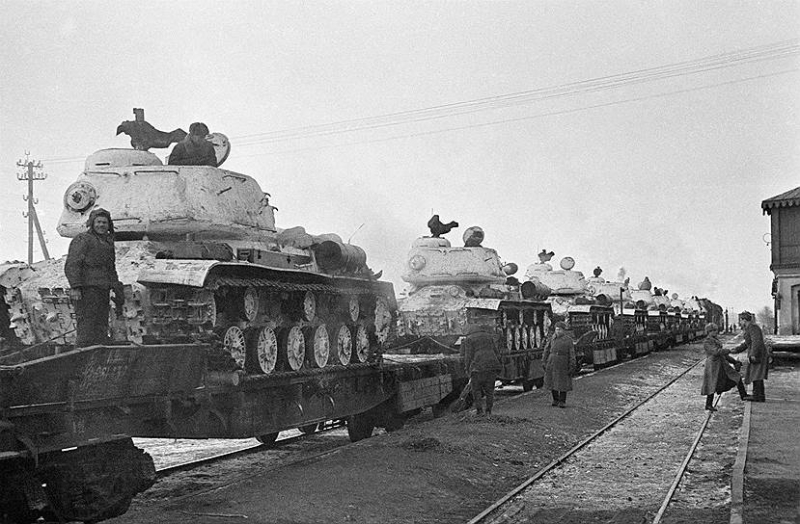
Trainload of tanks IS-2 from the junction Dubosekovo, winter 1945
Engine
IC-2 was equipped with a four-stroke V-shaped 12-cylinder diesel engine-2-IP 520 l. from. Starting the engine starter inertia was provided with manual and electric drives or compressed air from the two tanks in the fighting compartment of the machine. Electric inertia starter is an auxiliary electric motor 0,88 kW. Diesel-2-ICs packaged with a high-pressure fuel pump NK-1 RNA vserezhimnym regulator 1 and the fuel supply corrector. To clean the air entering the engine is used a filter of the "multi-cyclone". Also in the engine-transmission compartment installed heating device to facilitate engine starting in cold weather. They could also be used for heating the crew compartment of the machine. IS-2 had three fuel tanks, two of which were located in the fighting compartment, and one - in power pack. The tank is also equipped with four external additional fuel tanks capacity 360 l, unrelated to engine fuel system.
Transmission
Tank JS-2 equipped with a manual transmission, which included:
– multidisc main clutch "steel Ferodo" dry friction;
– four-stage gearbox with dual (8 gears forward and 2 ago; second reverse gear can be obtained only in theory, in a real car, she is not);
– two board-stage planetary rotation mechanism with a multi-plate friction locking clutch dry "steel on steel" and belt brakes;
– two-row combination of onboard gear.
All transmission control actuators - mechanical. Compared with the previous model KV-85 heavy tank, new powertrain are planetary rotation mechanisms. Use of this site helped raise the overall reliability of the transmission as a whole, which it has just been the most significant drawback of the chassis KV series of tanks and machines on its base.
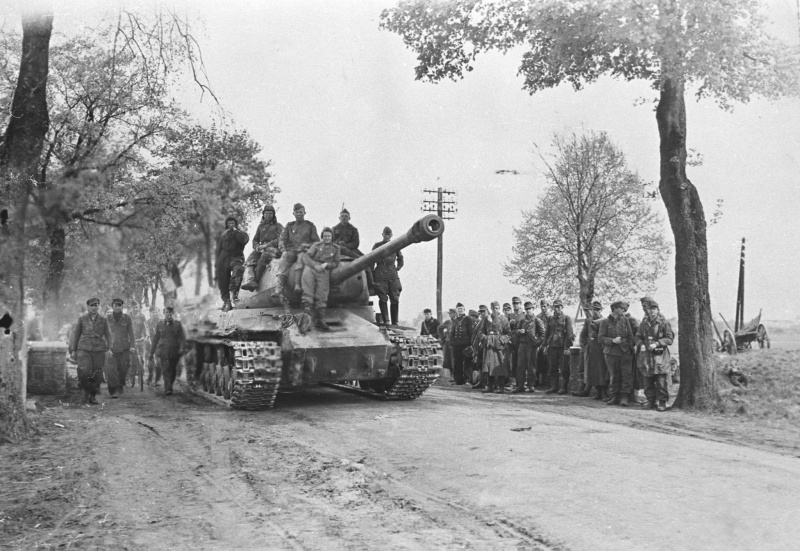
Soviet heavy tank IS-2 on the road a group of German prisoners of war
Chassis
Suspension of EC-2 Individual torsion for each of the 6 gable unit-cast rollers of small diameter (550 mm) on each side. Next to each track roller welded to the hull of travel stops suspension balancers. Driving wheels with removable gear rings lantern meshing located behind, and idlers were identical supporting rollers. The upper branch tracks supported by three small solid rubber supporting rollers on each side; These rollers have been borrowed from the design of the tank KV-85. Mechanism track tension - screw; each caterpillar consisted of 86 odnogrebnevyh shoe width 650 mm.
Mobility
Heavy Tank of its mobility, the IS-2 was regarded by representatives of the Red Army satisfactorily, although at 520 horsepower diesel engine and a weight 46 ie its specific power available was the lowest among the high-volume Soviet medium and heavy tanks. Specific ground pressure was about 0,8 kg / cm², far exceeds the rate of German heavy and medium tanks. The maximum speed is not exceeded 35 kmh, but this feature was not for heavy breakthrough tank defining, because the main use of tactical battle was in the same ranks infantry, and designed a mobile T-34 for the development of breakthrough. In case of weak or lack of resistance of the enemy IS-2 could partially be used to deepen breakthrough, but the characteristics of mobility is not conducive to such use.
In comparison with the German heavy tanks (of the Soviet classification) IS-2 occupies an intermediate position between the "Panther" and "Tiger" two modifications. "Panther", with its 700-horsepower Maybach HL 230 It has the best specific power available, maximum and average speed. However, it should be taken into account, that "Panther" it was not a breakthrough tank and intended for other combat tasks, where speed and operational and tactical mobility were among the defining parameters. 55-ton "Tiger I» had comparable with EC-2 power density, and 68-ton "Tiger II» EC-2 lost by this parameter. Also of note, that all three types of German tanks different from the IC 2 higher ground pressure, which imposes certain imprint on their tactical application. In particular, in order to save expensive and trudnoremontiruemoy material part of the German heavy tank battalions, they are rarely used outside of roads (overloaded engine and transmission, increases the chances of getting stuck tank), while the IS-2 was more suited to off-road. It should also be noted, that in Germany and Western Europe with a developed road network, this lack of German machines were practically insignificant. On the other hand, "Ironing" trenches "lunar" front edge for the "tigers" was fraught with failure of transmission, while the IS-2 was quite suitable for this purpose.
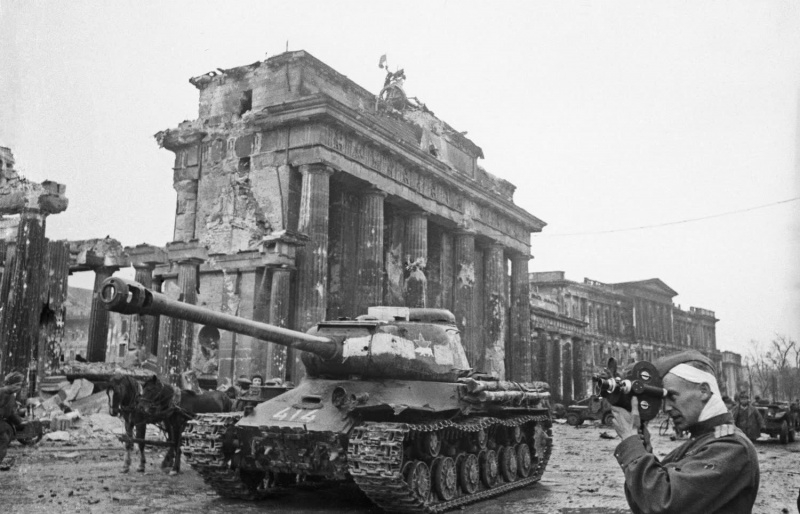
Frontline cameraman Roman Karmen Lazarevic (1906—1978) is shooting near the tank IS-2 7th Guards Heavy Tank Brigade at the Brandenburg Gate. Tactical number machine "414" is applied to the front hull.
electrics
Wiring in the IS-2 tank was a single-wire, the second wire served hull of the machine. power sources (operating voltages 12 and 24 AT) It was GT-4563A generator with relay control PPA-24F power 1 kW and two series-connected rechargeable batteries 6 of the brand-STE-128 total capacity 128 Ah. electricity consumers included:
– electric turret;
– exterior and interior car lighting, lighting equipment scopes and scales of measuring instruments;
– External sound and alarm circuit from the landing to the carriage of the machine;
– instrumentations (ammeter and voltmeter);
– electric trigger cannons and machine guns;
– means of communication - the radio station and tank intercom;
– electrical motor group - motor inertia starter, bobbin spark engine start and so the winter. d.
Surveillance and sights
Luke commander and workplace charging were equipped with Mk IV periscopes for monitoring the surroundings inside the machine. Commander's cupola had six observation slits with protective glasses. The driver IC 2 mod. 1943 g. in combat conducted observation through viewing device with triplex, which protects the armored shutter. This observation device installed in an armored hatch-stopper for the frontal armor plate in the longitudinal axial line of the machine. In a quiet environment, this hatch-stopper can be pushed forward, providing a driver-mechanic more convenient immediate review of his workplace. In late modification of armor spryamlonnoy hatch-stopper was abolished, and a driver was watching the situation through a slit in the front armor plate, using a viewing instrument with glass blocks. Peephole and outside of the appliance are protected by an armored hood flat, welded to the body of the tank.
For firing the IS-2 was equipped with a telescopic sight cannon scrap TS-17 for direct fire. Early series cars are also equipped with a periscope sight PT4-17, but he was subsequently abolished, and in its place was installed another device Mk IV. This improved review for gunner, but the lack of a periscope sight makes it difficult to self-firing from covered positions. To be able to fire in a night-time sight scales were lighting device. Stern DT machine gun could be completed with a PU scope of a sniper rifle with a threefold increase. Anti-aircraft machine gun DSK completed with red-dot sight K-8T.
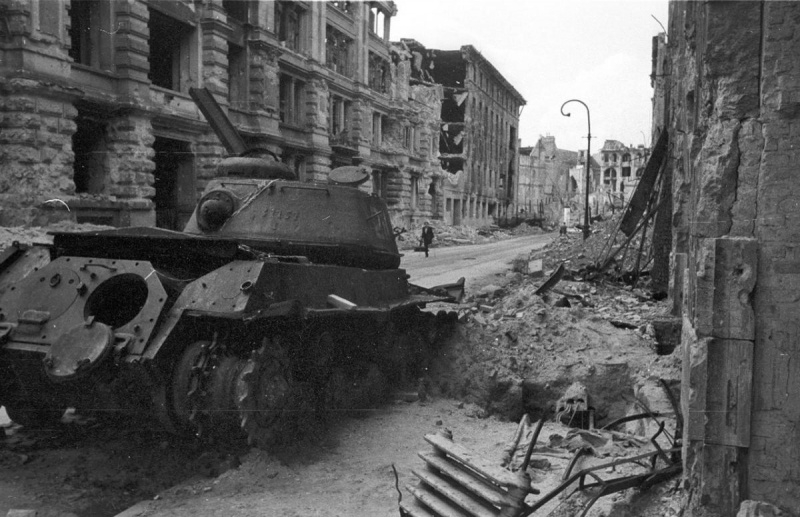
Padded Soviet heavy tank IS-2 on Beutshtrasse (Beuthstraße) in Berlin after the war. In the background of the road is a war invalid.
Means of communication
Communication tools include a radio station 10P (or 10RK-26) and intercom TPU-4-Bis on 4 subscriber. 10R radio or 10RK is a set of transmitter, receiver and umformerov (one-anchor motor-generators) for their food, be connected to the onboard power supply voltage 24 AT.
10P is a shorter tube-simplex transceiver, operating in the frequency range of 3,75 to 6 MHz (respectively wavelengths from 50 to 80 m). Parked in a telephone communication range (voice) mode reaches 20-25 km, the move is somewhat decreased. Most of the communication range can be obtained in telegraph mode, when the information is transmitted in Morse code telegraph key, or other discrete coding system. Frequency Stabilization carried removable quartz resonator, stepless adjustment of the frequency of missing. 10P allows you to link two fixed frequencies; quartz resonator used for another change of their 15 pairs included radio.
10RK radio is a technological improvement over the previous model 10P, it has become easier and cheaper to manufacture. This model has an opportunity to smooth the operation frequency, number of quartz resonators was reduced to 16. Characteristics of the communication range not undergone significant changes. Tank intercom TPU-4-Bis allowed to negotiate between the tank crew members, even in very noisy environment and the headset connect the headset (headphones and laringophones) to the radio for external communication.
modifications
In popular literature, the IS-2 war can be divided into two versions - arr. 1943 g. (with a stepped upper front part) and arr. 1944 g. (with the upper front part spryamlonnoy); However, a well-known military historian Colonel and. D. Yellow in his monograph "The tanks IS" distinguishes between six different series IS-2.
In the postwar time IS-2 have been upgraded with the engine replacement, installation of night vision devices, nadkrylkov caterpillar tracks. This variant was designated IS-2M
Machines based on the IS-2
On the basis of the IS-2 April 1944 year produced heavy tank destroyer ISU-122, armed with a 122 mm cannon A-19C (that ballistics identical D-25T, but it has a marker recoil device not equipped with a muzzle brake). In September of that year, in parallel with the ISU-122 serial production version of the new self-propelled gun with a long-barreled 122-mm gun was launched on the basis of EC-2 - ICS-122C. Her armament was a self-propelled version of the gun D-25S, which had a notable structural differences from the embodiment A tank-25T.
Earlier self-propelled gun ISU-152 considered as a machine based on the IS-2 would be somewhat inappropriate, although bogies they were almost identical. The prototype ISU-152 "Object 241" was built in October 1943 of the year, When the IS-2 itself existed only in the prototype stage, and undercarriage for both experimental machines (almost entirely in the IS-2, to a lesser extent in ISU-152) He borrowed from the previous model IS-1 heavy tank (IS-85).
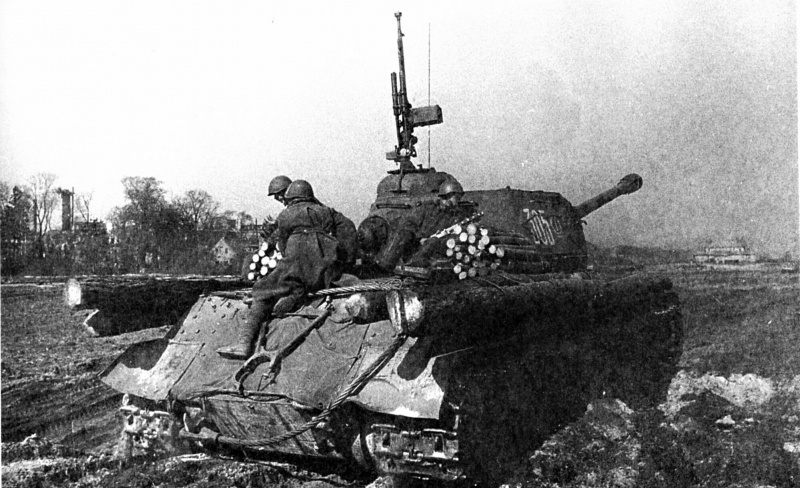
The machine is equipped 12,7 mm heavy machine gun DSK. To combat the lack of roads placed on board timber for self and fascines.
Organizational structure
IS-2, as KB-85 or IS-1, We arrived on arms separate Guards heavy tank breakthrough regiments (OGvTTP). Each had OGvTTP 21 Tank as part of 4 mouth of 5 machines plus a tank regiment commander. The regimental commander is typically held the rank of colonel or lieutenant colonel, company commanders - the rank of captain or first lieutenant. tank commander, usually, were lieutenants, and a driver - sergeants (often - techniques - junior lieutenants). The other members of the crew staffing were ordinary. OGvTTP usually has in its composition a few non-armored vehicles maintenance and support - trucks, jeeps or motorcycles, the number of personnel on the staff of the regiment was 214 human.
Also, in addition to the separate tank regiments, heavy tank IS-2 heavy tank brigades armed trohpolkovogo composition of regular number 65 cars each.
combat application
The first fight of the IS-2 with the "Tigers" took place in April 1944 years under Ternopil. In this battle involved the car of the 11th separate Guards heavy tank regiment. Guards separate heavy tank regiments (OGvTTP), armed with the IS-2 tanks, They took an active part in the hostilities of 1944-1945. In general, the new tank is fully met the expectations of command as a means of strengthening quality parts and units, designed to break in advance and well fortified enemy bands, as well as the assault on the town.
As examples of completely different results combat use of the IS-2 tanks can result in the following battle scenes with their participation:
– During the Lvov-Sandomierz operation known episode, when two IS-2 tank's 57-th Guards separate tank regiment, hiding in ambush, We stopped the armored forces greatly superior enemy forces. For two days the crews of two Soviet heavy tanks destroyed a total of 17 German tanks and self-propelled guns, removing the threat of liquidation of the bridgehead on the Vistula. Of them 9 Lyakhov and counts 8 counts Lukanina.
– In August 1944 year 71st OGvTTP participated in the defeat of the battalion "royal tigers" on the Sandomierz bridgehead. During this battle the IS-2 tanks knocked out six "royal tigers". Six weeks of fighting the regiment shot down and destroyed 17 German tanks, 2 SAU and 3 BTR. the loss amounted to 3 tank and burnt 7 padded.
-In October 1944 year 79th OGvTTP Serock held a bridgehead on the Narew River north of Serock. Enemy, Having a total of more than 200 tanks, I am trying to eliminate the bridgehead. 4 October 1944 year to 19:00 the position of the Soviet troops was threatening. AT 21:00 tankers in conjunction with the 44th Guards Rifle Division 105th Rifle Corps went on the attack. Going under heavy fire, they encountered heavy enemy tanks. It has been damaged and destroyed six German tanks T-V and T-VI. Losses are accounted for one IS-2 tank burned and one padded. TO 6 October More 4 Soviet, 3 German tanks and 2 German armored personnel carrier was lost. FROM 6 by 9 October regiment, able to create defense, I have not lost a single tank, with the burnt 11 heavy enemy machine. During these fights also distinguished crew of the JS-2 tanks under the command of Lieutenant Guard Ivan Khitsenko 30th Guards Heavy Tank Brigade. His tank platoon had received a task to keep the defense on the right flank. Platoon attacked column nazis. Khitsenko tank this fight fire gun knocked out seven enemy tanks "Tiger" and one rammed, before he was burned. The Germans could not break down the right wing.
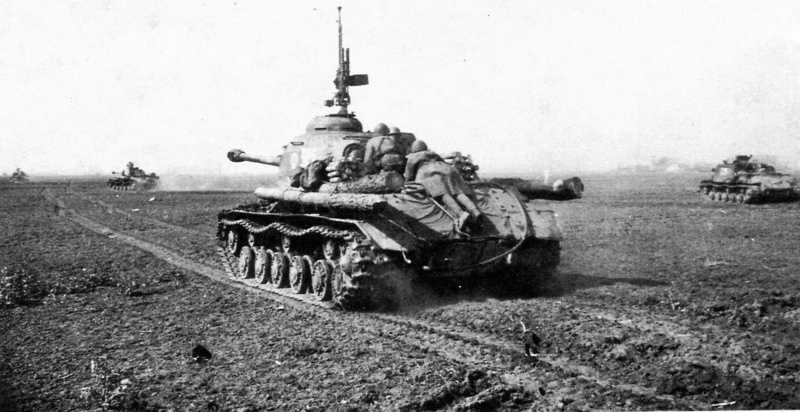
The machine is equipped 12,7 mm heavy machine gun DSK. To combat the lack of roads placed on board timber for self and fascines. Right moves SAU ISU-152.
– 78-and OHvTTP, stepping on Debrecen in Hungary, from 6 by 31 October destroyed 46 tanks (including 6 "Tigers"), 25 HEALTHY, 109 guns, 38 BTR, 60 machine-gun point, 2 storage of ammunition and 12 aircraft at the airport. Regiment loss amounted to two burnt by faustpatron IS-2, yet 16 tanks received varying degrees of damage.
– On the territory of the Reich battles were particularly spirited. 70-and OHvTTP, the run crossed the river and passed over Vistula 300 km, in late January, he came to the city Shneydemyulyu. Siege took two weeks and cost the regiment nine damaged cars. 82-and OHvTTP 8 February 11.00 angle forward 1st and 4th Panzer rotami launched an attack in the city district of Kreuzburg. AT 13:00 to 11 enemy tanks, accompanied by "artshturmov" counter-shelf unit, but, suffered losses, retreated. TO 20:00 Kreuzburg was taken. The day fighting regiment destroyed 4 tanka, 4 HEALTHY, 6 guns and 10 machine-gun point. Regiment loss for the day of battle, too, proved to be substantial: 11 tanks were hit, one stuck.
– The Vistula-Oder operation 80 minutes to OGvTTP 14 by 31 January 1945 year destroyed 19 Tanks and self-propelled guns of the enemy, 41 artillery piece, 15 pulyemyotnykh gnyozd, 10 mortars and 12 dugouts. Of 23 participated in the fighting machines none were irretrievably lost.
– 81-OGvTTP in th 3.30 16 February 1945 Year composed 16 tanks attacked Kukenov. The commander of the 144th Infantry Division, which was given a regiment, considered, EC-2 are capable of doing everything ourselves. Published in the IS-2 attack were met by flanking fire of the Germans, who burned two IS-2 and knocked out two more. 4-Panzer company closed out the three IS-2 of the second tank company on the outskirts of the settlement Nemretten, but the success could not develop without the cut Corps. Two EC-2 in this phase of the battle were hit. Within three hours of the tankers were fighting with the infantry, tanks and anti-tank guns of the enemy, losing nine more IS-2 padded. Attempts to captivate his infantry had no success. As a result, 16 Kukenov February and has not been taken, and the regiment was withdrawn from the fight for the restoration and maintenance of materiel. Of 15 including IS-2 as of 17 February 1945 Seven years were combat-ready, two were in need of repair average, three were not evacuated from the battlefield and three were to be written off (that is, they can add to the deadweight loss). Apparently, German side in this battle did not suffer serious damage, since the success of the regiment for 15-27 February 1945 year appear destroyed 4 tanka, 4 Armored, 17 guns and seized one assault gun. According to the documents, These successes have been achieved in the fight 15 February and 19-27 February, when the regiment recovered from CAUSED 16 February losses under Kukenenom.
– In the fighting in March 1945 on the territory of Poland particularly distinguished commander of the tank IS-2 Fedotov Mikhail A.. Only the first two and a half months 1945 , his tank destroyed 6 German tanks and self-propelled guns, 11 artillery, 2 mortar battery, 3 armored personnel carriers and several cars.
A huge role in the rapid restoration of combat capability of Soviet tank forces played a high survivability and maintainability ISov and created on the basis of their ACS. It was not uncommon, when the regiment, eve has lost most of its machines, after a day or two was again ready for battle. So, in the 88th to OGvTTP 25 in January there were only two serviceable tank, others were either knocked out, either out of order due to technical and other reasons, (including two drowned in the river). However, by 1 February operation back 15 rehabilitated and able-bodied cars.
88-th and 89th regiments stormed OGvTTP first under floodlights German positions with Kyustrinskogo bridgehead on the first day of the Berlin operation.
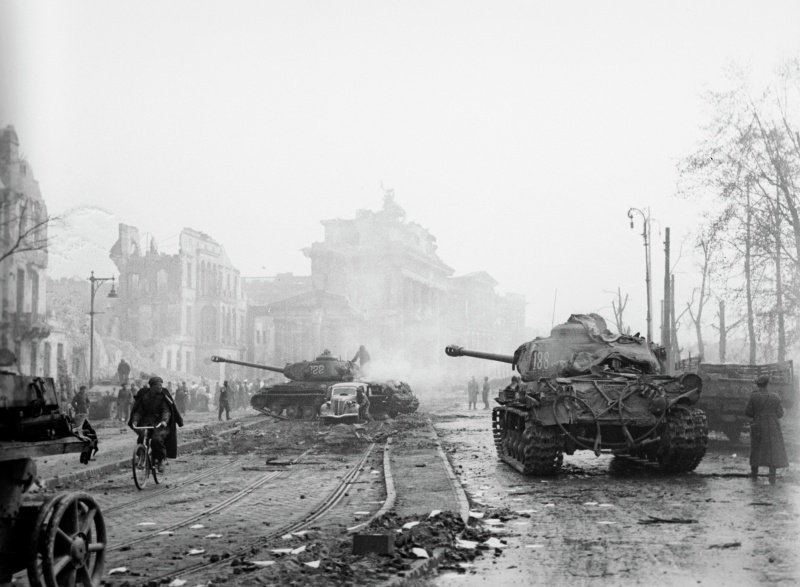
Soviet tanks IS-2 at Herman-Göring-Straße (Hermann Goering Street) in Berlin.
the city by storm
Together with ACS on its base of the IS-2 was actively used for assault actions fortified cities, such as Budapest, Breslau, Berlin. The tactics in such circumstances envisaged action OGvTTP assault groups of 1-2 infantry tanks accompanied by separation of several submachine, sniper or marksman and sometimes backpack flamethrower. In the case of weak resistance with assault tanks groups on the armor at full speed on streets to broke squares, areas, park, where you could take a defensive perimeter. In the presence of a strong fire fighters assault teams dismounted, and the tanks were longitudinal cross-fire along the streets, covering the promotion of forward infantry. The main task of the fighters assault group was to destroy the enemy granatomotchikov ("Faustnikov") and calculations towed anti-tank guns, while the IS-2 powerful fire destroyed the machine gun nests, were identified firing on positions of snipers, destroyed armored covers and bunkers. In the case of counter-attacking tanks and assault guns, the IS-2 was transferred to them the gravity of his fire, defending his infantry. When detecting barricades, ditches, blockages IS-2 destroyed them with his fire, or provide cover fire sappers, to remove barriers. Especially important attention to the instructions for the tank crews and gunners paid maneuver, even in cramped conditions of urban warfare, Action on a "left out of hiding, shot, gone into hiding ".
In these battles, the IS-2 suffered considerable losses, And popular opinion attributes their exceptional efficiency of the German rocket-propelled grenade "Panzerfaust" and "panzerschreck". However, the statistics of lost Soviet tanks in Berlin operation does not speak in favor of this version. More 85 % tanks put out of action falls on the receiver tank and anti-tank artillery German, and the available instances of mass destruction, the IS-2 cumulative grenades attributed mainly gross violations of the tactics of urban combat commanders of the Red Army, when the tanks are thrown forward without proper cover infantry. Unfortunately for Soviet side, in many cases, attempts to take the city from the flight without the use of tactical assault groups led to more than a serious loss.
About the heat of fighting demonstrated by the fact, EC-2 crews in urban combat (eg, Berlin storming) spent a day two - three ammunition, sometimes somehow finding in the tank space for additional rounds (to 42) instead 28 staff. As an illustration to bring the episode involving the IS-2 34th OGvTTP 27 April 1945 of the year. Assault group composed of IC-2 and eight riflemen broke through to the Lutheran church on Kurfuerstenstrasse, but I ran into a strong reference point, SS soldiers held by forces of over hundreds. The tank hit a mine, there died loader and gunner, then the Germans cut their infantry fire from the IS-2, creating favorable conditions for the "faustnikov". Hit cumulative grenades killed the commander, remained alive only a driver Sergeant Herman Shashkoff. The second hit faustpatrona IS-2 was set on fire in the engine compartment, but the sergeant was able to deploy the tank so, to bring down to nearby wall and smother the flames of its fragments. Then the bodies of dead comrades stood behind the cannon and machine guns, and the fire led to the complete exhaustion of ammunition, after that, opening hatch, He continued to fight with grenades. According to the monograph "IP tanks in the fighting", after, like the tank reached the Soviet soldiers, bloody Shashkova found lying at the bottom with a knife in his hand. In his memoirs, In. AND. Chuikov adds, that brave tank commander denied suggestions of the enemy to surrender and died shortly after his approach, and around the damaged IC 2 strewn over tens killed three SS. elaboration: dc. Sergeant Herman Shashkoff died three months earlier, when storming g. Poznan in January 1945, Decree PVS 23.03.1945 g. he was posthumously awarded the title Hero of the Soviet Union.
IS-2 tanks provided fire support for the assault of the Reichstag:
– 30 April fighting very close to the walls of the Reichstag. On the morning of the 88th heavy tank regiment, crossing the Spree river on a bridge Moltke, He took up firing positions on the waterfront Kronprintsenufer. AT 11.30 part of the 79th Infantry Corps went on the offensive and crossed the ditch at Königsplatz in front of the Reichstag. AT 13.00 regiment tanks, participating in general artillery preparation preceding the assault, opened direct fire at the Reichstag. AT 18.30 Regiment fire their support and the second assault on the Reichstag, and only with the beginning of the battle tanks inside the building ceased its bombardment.
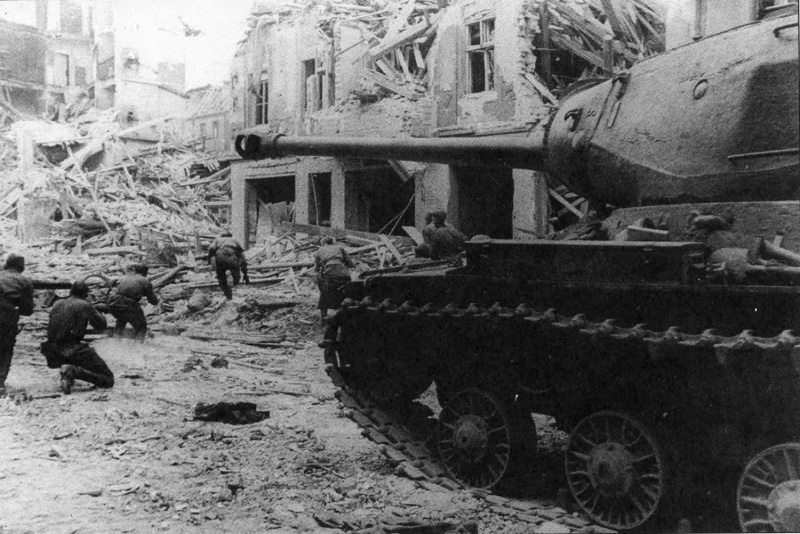
Tank JS-2 Hero of the Soviet Union guards captain FA. Lipatkin support infantry in the battle on the streets of Berlin.
Clashes with "Tiger"
The issue of fighting episodes involving the IS-2 and German heavy tank "Tiger I» or «Tiger II» is one of the most hotly debated on the forums or military computer-gaming orientation. The intensity of the dispute have maintained links to documents of various departments of the Red Army and the Wehrmacht, and the memoirs of prominent warlords and tankers that era. They, usually, featured tens or hundreds of destroyed or wrecked IS-2 and "Tigers". However, it should take into account the fact, that with the, and on the other hand there have been numerous Registry and errors in determining the type of enemy vehicles; Furthermore, often do not converge place, time and division, engage in combat. Therefore, the most reliable sources are no reports about the number of damaged and destroyed enemy vehicles, and reports on the available material and the reports of the teams trophy. Also of note, often write off the destroyed equipment officially occurs later, than fight, in which it was lost, and sent to repair wrecked tanks can not be considered for the irretrievable loss, and it introduces additional complexity in an accurate account of the outcome of a battle. According to the results of its analysis of the documents, known historians M. Bariatinsky and M. Svirin argue about quite a few episodes of confrontation "Tigers", and IC-2. This is not surprising, since heavy breakthrough tanks not intended, in general, to fight with heavy tanks. The best known with proven episodes involving these tanks are fighting 71st OGvTTP with "Tiger II» 501st heavy tank battalion under oglenduv and collision under Lisuvom. In both cases, both sides suffered heavy losses, eg, under oglenduv killed the commander of the 71st OGvTTP Guard Lt. Col. Yudin, and his regiment lost burnt 3 IS-2 and more 7 padded (of which 4 They were repaired on their own regiment). In the battle of Lisuvom killed the commander of 424 th Heavy Tank Battalion, Major Semish, and he lost almost the entire battalion materiel, the Soviet side also killed the commander of the 61st Armored Brigade N. D. Zhukov. Also worth noting, that the well-known IS-2 drawback - low rate - in a real combat situation was not so much influence on its outcome: lieutenant Klïmenkov, Belyakov knocked out and removed and destroyed some "Tiger II», And for the most recent system output it took a few hits.
From the memoirs of Alexander Mikhailovich Fadina (Artem Drabkin - "I fought on the T-34"):
– We stood in caponiers, dug on a hillside vineyard. One kilometer before us a monastery. Suddenly, from behind a stone wall fence crawls "Tiger". Has stopped. Him another, then another. Crept out of their ten pieces. Well, think, - Khan, they would get us. Fear's eyes are always great. Nowhere, are two of our IS-2. I have them for the first time saw. We caught up with us, stood up. Two "Tiger" are separated and go a little forward, kind of like a duel. Our forestalled them with a shot and demolished both towers. And the rest - again, times and a rock.
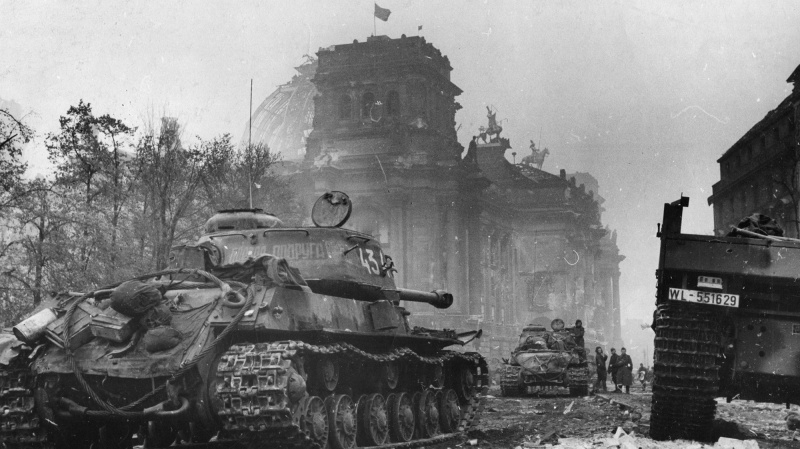
Soviet tanks IS-2 7th Guards Tank Brigade in the Reichstag. In the foreground - the tank number 434 "Fighting girlfriend".
The causes of loss
Enough informative report on the fighting 72nd OGvTTP with 20 April 10 May 1944 of the year, wherein the detail indicated causes irretrievable loss EC-2 in battles:
– tank number 40247 20 April Gerasimuv district came under artillery fire SAU "Ferdinand" from the distance of 1500-1200 m. The crew was able to answer with one shot, because it refused to the trigger gun. Leaving out of the fire SAU, IS-2 was 5 hits in the frontal part of the housing, do not harm him. At this time, the other self-propelled guns "Ferdinand" quietly approached from the flank at a distance of 600-700 m and armor-piercing projectile pierced the right side of the tank to the engine area. The crew left to stop the car, which soon caught fire.
– tank number 40255 from a distance of 1000-1100 m I received a direct hit 88-mm projectile "Tiger" tank in a lower front inclined armor plate, resulting in a broken left fuel tank, a driver was wounded by shrapnel armor, and the other crew members received light burns. The tank burned.
– tank number 4032, after a resist from a distance of three meters 1500-1000 falling out of the tank "Tiger" in the front housing, It was destroyed by fire, the other "Tiger" from a distance of 500-400 m. 88-mm armor piercing projectile shot from the front right side of the lower sheet, occurred ignition of gunpowder shells, and then the fuel. tankers, abandoned car, carried wounded the driver in the rear.
– tank number 40260 burned by contact with a side port 88-mm projectile tank "tiger" with the distance 500 m. Shell destroyed the engine, tank caught fire, the tank commander and gunner were injured.
– tank number 40244 I received a direct hit by an armor-piercing projectile of the tank "tiger" with distance 800-1000 m in starboard hull. The driver was killed, and in tank ignited diesel, vylivsheesya from the destroyed right fuel tank. The tank was evacuated and then blown sappers.
– tank number 40263 burned by contact with the two shells in the side.
– Tank number 40273 ... received two direct hits: first - the tower, immediately followed by the second - in the side sheet in the vicinity of the engine compartment. Battle in the calculation of the tower killed, and a driver was injured. The tank is left in enemy territory.
– tank number 40254 He was hit by fire SAU "Ferdinand", lie in ambush. The first shell struck the turret boxes are not, but the second shell was punctured side of the hull and disabled the engine. The crew evacuated, and the car burned.
In this way, This document confirms, EC-2 fire safety deteriorated noted above placing the fuel tanks in the inhabited places of the machine, partly offset by the worst flammability of diesel fuel compared to gasoline. Also, reports of the front piece of evidence, successfully set on fire were extinguished IS-2 with their own crews using regular tetrahlornogo extinguisher. It should be noted, that quenching was performed in masks - falling on the red-hot surface, carbon tetrachloride partially oxidized to phosgene, which is a potent poisonous asphyxiating. Already at that time in the tanks of other countries have begun to be used more safe carbon dioxide fire extinguishers. As well as other tanks of the time (with a few exceptions), IS-2 did not differ explosion safety because of the location of the ammunition in the fighting compartment: explosion boeukladki guaranteed to destroy tanks with all hands.
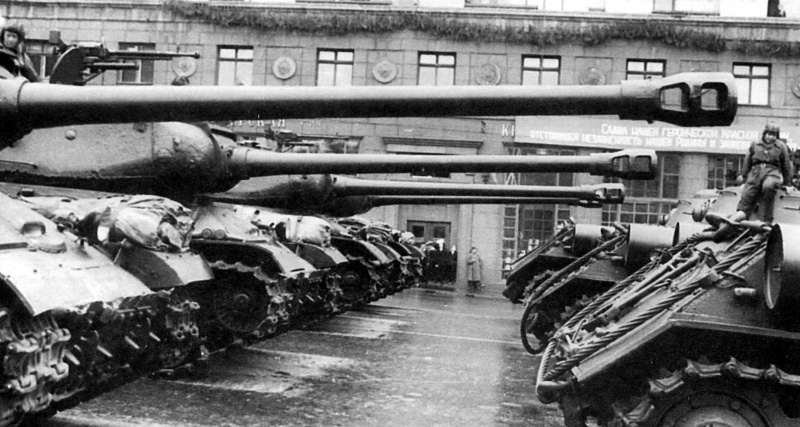
IS-2 tanks in Moscow on Gorky Street (now - Tver) before joining the Red Square during the parade in honor of Victory 24 June 1945 of the year.
IS-2 in Polish and Czechoslovak parts
Polish Army received 71 IP-2 for the formation of the 4th and 5th tanks heavy regiments. During the fighting in Pomerania 4th regiment destroyed 31 enemy tank, losing 14 own. Both regiments took part in the Berlin operation. After the war, the Poles left 26 tanks (wherein 21 car back the Red Army).
Czechoslovak units received several JS-2 in spring 1945 of the year.
Evaluation of the project
IS-2 was the most powerful Soviet tanks, participated in the Great Patriotic War, and one of the best machines of the world of his time in the weight category of 40-50 m, and in the class of heavy breakthrough tanks. However, the assessment of the machine is greatly complicated by the propaganda of both sides involved in the war and a large number of post-war myths, one way or another connected with the ideological struggle of the Soviet Union or against it.
From the combination of the power of weapons and armor IS-2 was superior to all the tanks of the Second World War (NTV “Warfare”), yielding many different other on different individual indicators (eg, for rate of inferior T-6, on the frontal armor of the Tiger-2). Cast body parts on all machines – tower and turret ring box. With a shortage of rolled armor as the frontal part and a number of others were made of cast armor in simple technical terms low-skilled workers the most simple means, which of course increased the real possibilities for the production of machines in war. Such armor is often defective and often had a rough surface which further led to deviations from the estimated armor thickness on both sides. IS-2 were held at 1000 km without a break, whereas, eg, Panthers suffered huge non-combat losses (dozens of %) for technical reasons (at much higher costs of production and repair), and not only during “battle of Kursk”.
With all the wide popularity of IP-2, his place among the Soviet machines quite often questioned from different angles. From the outset, the IS-2 to some extent regarded as a guidance CHKZ imposed on top of the machine, especially since the tower with a 122-mm gun was put entirely on the KV-85 base-tuned in the production of "their" (prototype version of the HF-122). Despite, well. I. Kotin was one of the leaders CHKZ, tank IS, developed under his leadership at the pilot plant number 100, I perceived to CHKZ as a foreign car. Consequently, on the creation of "their" heavy tank CHKZ in secrecy were parallel operation, which was generally promising, and not without success; but that there were two big problems: and then the light appears projects and prototypes improved on heavy tanks paper, What IS-2, and finishing the last was "creaking". To remedy the situation in the People's Commissar of tank. A. Malyshev had to use all of its administrative power, to bring the issue of the quality delivered to the troops IS-2 up to a decent level.
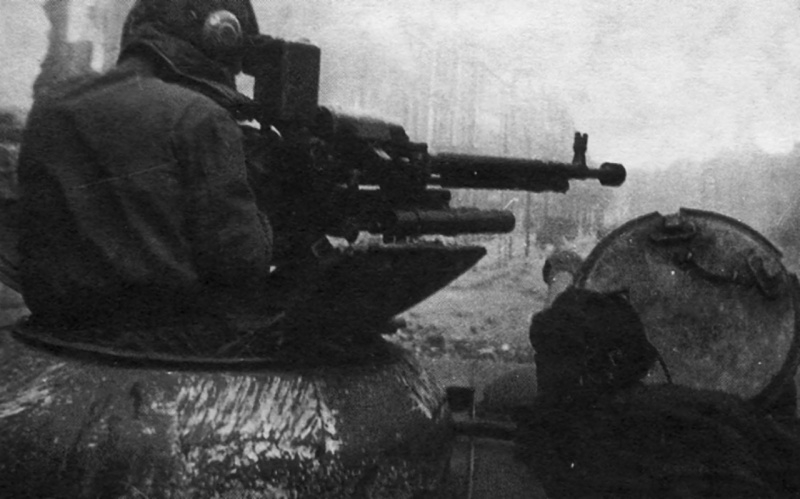
Soviet tankers 62nd Guards Heavy Tank Regiment in street fighting in Danzig. Mounted on the tank IS-2 heavy machine gun DSK used to kill enemy soldiers, armed with antitank grenade launchers.
A second aspect of the "early" question in the right way, selected for heavy breakthrough tank, IP is the presence tank prototypes with 100mm guns. Despite the higher theoretical rate, 100-mm instrument in 1944 year could not possibly compete with the 122-mm gun D-25T. Military historian M. n. Svirin gives the following reasons for choosing 122 mm cannon:
– The decisive factor for the choice of the D-25T he calls the, By the beginning of the selection artillery system for the IS-2 weapons in September 1943 of the year, suitable for installation in it 100-mm shells were not, and other options presented - 107 mm cannon and howitzer various calibers clearly inferior to the 122 mm cannon. 100-mm gun S-34 has repeatedly failed to withstand the test of government and by February 1944 year still was not prepared for adopting. Appeared later D-10T after repeated revisions was put into service only 3 July 1944 of the year, moreover, the production of armor-piercing shells for it only began in November of the same year.
– The dense arrangement of the tank, What was ICs, separate loading the gun helps to place more ammo, than the unitary smaller caliber projectiles, paradoxically. Unitary cartridge was long compared to the single shell and the liner, the maximum that was possible to do with it - post 36 100-mm cartridges, of which 6 almost could not be delivered to the gun (Keep away from the driver's place). Ammunition same 122mm gun was 28 shots and in some cases brought to 42.
– The second apparent paradox 100mm unitary cartridge - almost the same rate of fire, as at 122 mm separate loading - a consequence of all of the same length and a great patron of the crew compartment stesnonnosti. In the parking lot in a quiet environment, he did win in loading speed, but in the confusion of battle loading was carried out in the tank is moving at a pretty bumpy ride, and in such circumstances the test showed, that the gain in speed is negligible loading.
– Common statement, that armor 100 mm cannon above that of the 122-mm D-25T, based on firing tables mid-1950s, and 1944 year on this parameter guns were equal under the influence of Soviet armor, and firing at German tanks with armor increased fragility 122 mm projectile penetration of the effective range of 85mm oblique armor (upper frontal part "Panther") almost twice as large as 100 mm due to the greater mass and kinetic energy (it may be noted in passing, that the German 75-mm and 88-mm shells had more action on the worst of the German armor, ie even in the absence of alloying elements German metallurgists managed to achieve a decent resistance against the caliber armor-piercing shells of medium caliber). Besides, high-explosive and fragmentation power of 122-mm shells were significantly stronger, than 100mm.
Against this background it can be argued, that the IS-2 was the only Soviet heavy tanks, which in all of its combat and operational characteristics could meet the requirements of the second half of the war the Red Army to conduct offensive operations to overcoming the powerful and deeply layered defense. To adequately IS-2 counter enemy required heavy antitank weapons, that, usually, were expensive, it is difficult to make up for and not always present in a particular place at the right time. The same thing happened in reverse order in the earlier 1943 , with the massive use of the German heavy tanks "Tiger", that was taken into account in the development of the Soviet command tactics of heavy tanks.
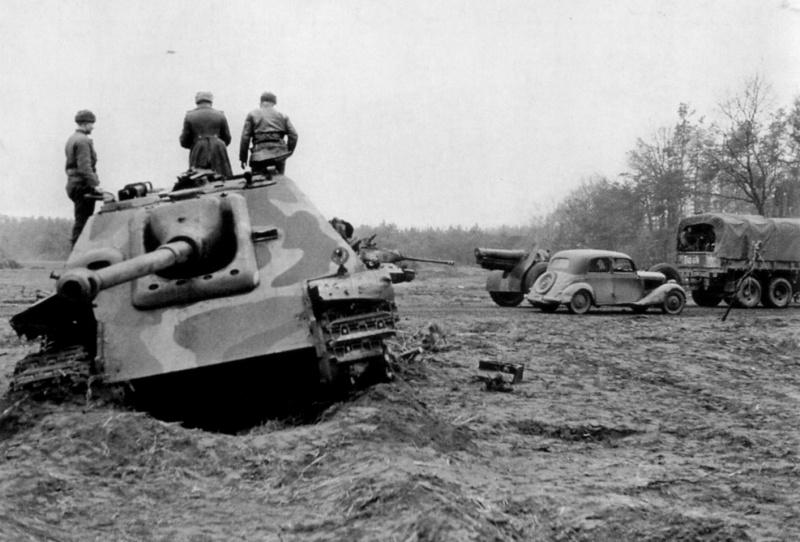
A Soviet officer examining lined in East Prussia, a German self-propelled guns "jagdpanther" (Sd.Kfz.173 Jagdpanther). Right - the staff car in a truck with artillery 122 mm howitzer sample 1910/30 years, in the background shot down a Soviet tank IS-2.
Production
In addition to the production CHKZ, in March 1945 of the year 5 IS-2 collected in Leningrad LB restored and still last 5 tanks, he passed in June. During the period from December 1943 June 1945 It had been issued 3385 IS-2 tanks.
The post-war fate of the IS-2
IS-2 participated in the Korean War - there are references to the use of the IS-2 the People's Liberation Army of China, but without any details. According to the Russian researcher Mikhail Bariatinskii, a number of IS-2 Chinese troops handed over Vietnam People's Army (VNA), who used them during the Indochina War. However, Western sources say, that in the course of this war BHA did not use armored vehicles. The official history of the VNA does not mention in the list of tanks in existence at the time of the war of weapons and equipment, and the list of military units, existed in the same period, no armored. According to official data of the Vietnamese, BHA armored forces were set up in 1959 year, and "baptism of fire" received 1968 year.
IS-2M
AT 1957 , the Soviet IS-2 underwent a major renovation and modernization with the aim of tightening its performance to the level of, corresponding service in peacetime. Modernization works were as follows:
– engine B-2-IC was replaced by the B-54K-EC;
– installed new transmission;
– replaced rollers and guide wheels;
– introduced additional fuel tank;
– Ammo increased to 35 shells;
– modified tower design - in particular, Instead aft fan's laid pulemёta;
– replaced hoist tools;
– installed a new radio station;
– installed new fire-fighting equipment, wings of different shape, promoted a number of other minor changes.
In the early 1960s, two regiments IS-2M were delivered to Cuba; by the end of the 1990s, they are still used in the coastal defense of the country. At the same time two regiments IS-2M received DPRK.
In the USSR IS-2M for a long time we were in service, since 1960 mainly in the reserve. A significant number of these tanks were mounted on the border of the PRC as a long-term stationary gun emplacements (the legacy of the German experience of the Second World War). Some of the tanks used in the same place as the mobile firing points - machine is in a park, and the alarm should have been nominated in a specially constructed tank trenches. Nevertheless, IS-2 tank officially continued to be among the working examples of armored vehicles, periodically this type of car involved in the exercises (in particular, at 1982 year in the Odessa Military District). The official order of withdrawal of EC-2M with the Russian Army came only 1995 year. By the early 2000s, the surviving IS-2 tanks - firing points as part of the fortified areas in the Russian-Chinese border - have also cut into the metal.
preserved specimens
Many of the IS-2 steel exhibits museums. IS-2 is an exhibit Panzer museum in Kubinka, represented in the collections of the museum-panorama "Battle of Stalingrad" in Volgograd, the museum-diorama "Fire Arc" in Belgorod, at the Museum of heroic defense and liberation of Sevastopol on Sapun Hill in Sebastopol, Museum of military glory Omsk g. Omsk, at the Museum of Russian military history of the Istra district of Moscow region, and a number of other museums.
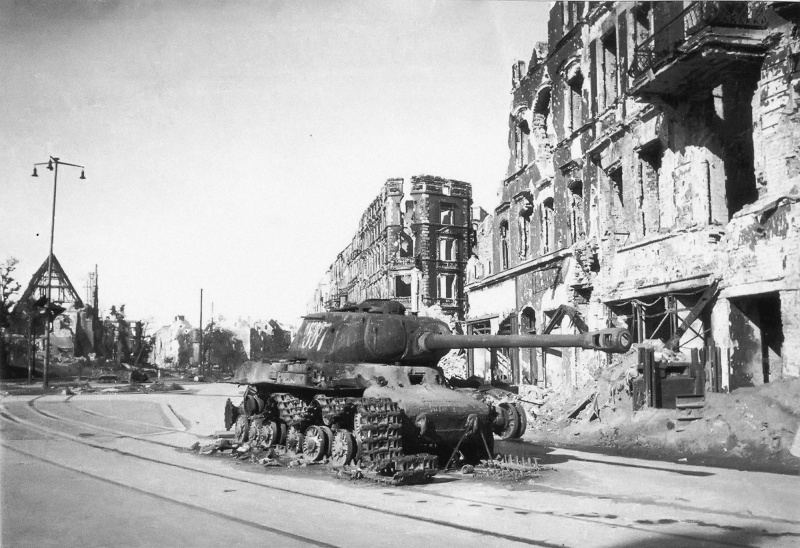
Soviet tank IS-2 №537 Lieutenant BI. Degtyareva from the 87th separate Guards Heavy Tank Regiment, podbityj in Štrigauer-plac (Striegauer place) in the German city of Breslau (now Wroclaw, Poland). Tank is known for photos of Anatoly Yegorov "Moment Musical". FROM 1 by 7 April Regiment in the 5 IS-2 tanks supported the infantry 112 th and 359 th Infantry Division in the south-western part of the city. for 7 days of fighting, Soviet troops advanced only a few blocks. More proactive tank regiment did not lead. IS-2 in the photo - the first releases, with inspection "hatch-stopper" of the driver.
The performance characteristics of the IS-2
Crew, pers.: 4
years of production: 1943—1945
years of operation: 1944—1995
The number of issued, PC.: 3395
The layout: classical
All IS-2
– 46 tonnes
The dimensions of the IS-2
– body Length, mm: 6770
– Length with gun forward, mm: 9830
– housing width, mm: 3070
– Height, mm: 2630
– Clearance, mm: 420
Armor IS-2
– Type broni: rolled high hardness, medium hardness cast
– housing forehead (top), mm / city.: 120 / 60°
– housing forehead (through), mm / city.: 100 / −30°
– body board (top), mm / city.: 90-120 / 15°
– body board (through), mm / city.: 90 / 0°
– housing feed (top), mm / city.: 60 / 49°
– housing feed (through), mm / city.: 60 / −41°
– Bottom, mm: 20
– corps roof, mm: 30
– tower forehead, mm / city.: 100
– gun mantlet, mm / city.: 100
– board towers, mm / city.: 100 / 20°
– tower feed, mm / city.: 100 / 30°
– tower roof, mm: 30
Armament IS-2
– Caliber guns and stamp: 122-mm D-25T
– gun type: rifled tank gun
– barrel length, calibres: 48
– gun ammunition: 28
– firing range, km: ~ 4
– sights: S-17
– Shotgun: 3 × 7,62-mm DT, 1 × 12,7-mm DShK (beginning with 1944 city)
Engine IS-2
– engine's type: V-shaped four-cycle 12-cylinder V-diesel 2IS
– Engine power, l. from.: 520
The speed of the IS-2
– Road speed, kmh: 37
– Speed over rough terrain, kmh: 10—15
– Cruising on the highway, km: 240
– Cruising cross country, km: 160
– power density, l. p. / m: 11,3
– suspension type: individual torsion bar
– Unit ground pressure, kg / cm²: 0,8
– Gradeability, city.: 36°
– to overcome the wall, m: 1
– trench, m: 2,5
– fording, m: 1,3
Foto IS-2
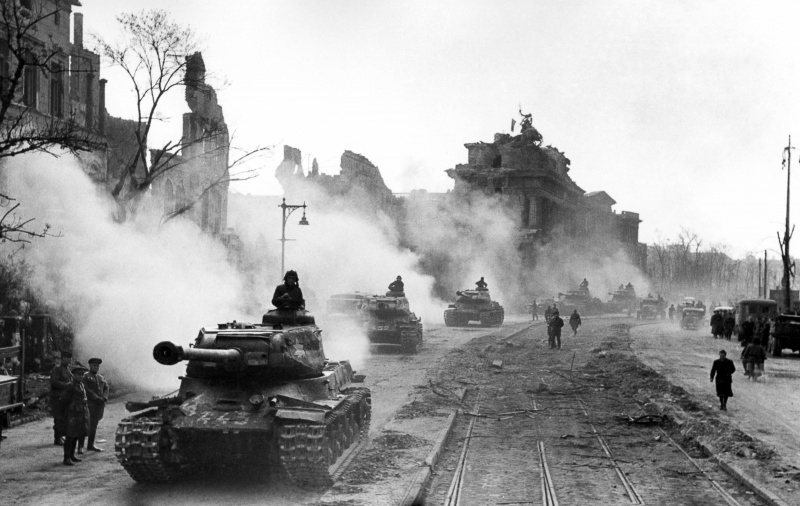
Soviet heavy tank IS-2 from the 7 th Guards separate heavy tank brigade in Berlin.
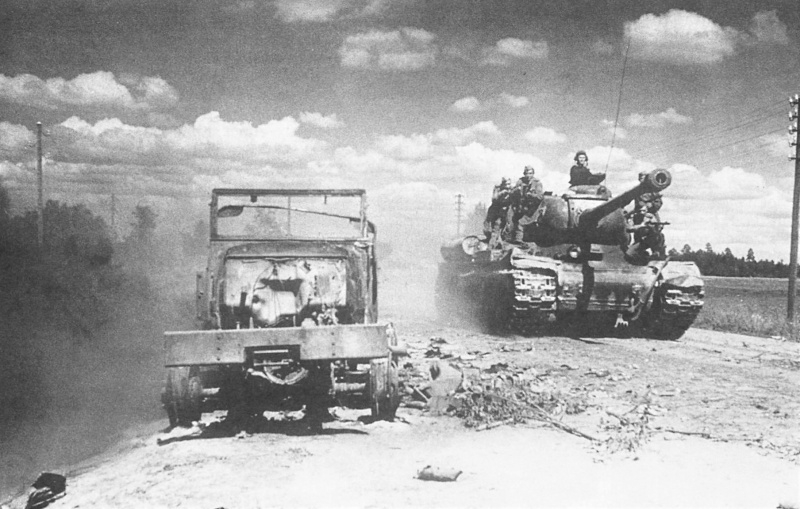
IS-2 tank with troops on board moves on the Riga highway. On roadside broken and burned truck Studebaker US6.







